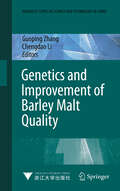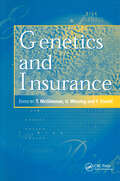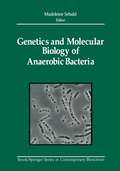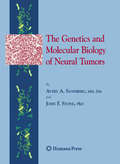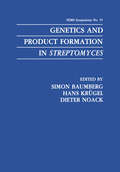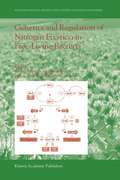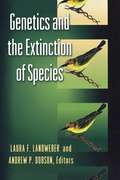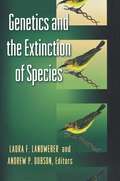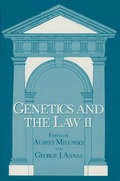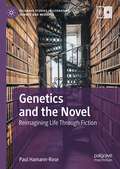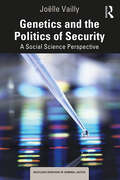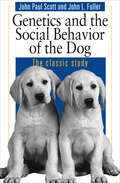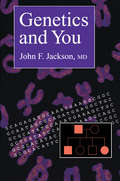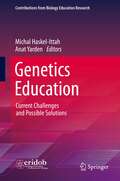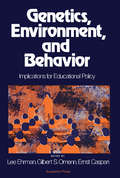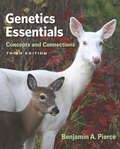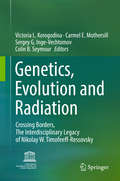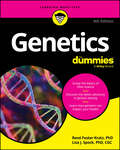- Table View
- List View
Genetics and Improvement of Barley Malt Quality (Advanced Topics in Science and Technology in China)
by Guoping Zhang Chengdao LiGenetics and Improvement of Barley Malt Quality presents up-to-date developments in barley production and breeding. The book is divided into nine chapters, including barley production and consumption, germplasm and utilization, chemical composition, protein and protein components, carbohydrates and sugars, starch degrading enzymes, endosperm cell walls and malting quality, genomics and malting quality improvement, and marker-assisted selection for malting quality. The information will be especially useful to barley breeders, malsters, brewers, biochemists, barley quality specialists, molecular geneticists, and biotechnologists. This book may also serve as reference text for post-graduate students and barley researchers. The authors for each chapter are the experts and frontier researchers in the specific areas. Professor Guoping Zhang is a barley breeder and crop physiologist in Department of Agronomy, Zhejiang University of China. Dr. Chengdao Li is a senior molecular geneticist and barley breeder in Department of Agriculture & Food, Western Australia. He is also an adjunct professor in Murdoch University of Australia and Zhejiang University of China.
Genetics and Insurance
by Francois Ewald T. McGleenan Urban WiesingCompiled by a well known and respected team of editors and contributors from interdisciplinary backgrounds, this book has its origins in the Euroscreen project, a research project funded by the European Commission to examine the legal and ethical issues arising from the use of genetic testing and screening since 1990. Contributors from members of a sub-group look at the likely impact of genetic testing on insurance.It will be published at a point when the significant controversy surrounding this issue will have intensified throughout the European Union. Although taking a European perspective, it addresses US issues where there is a strong interest in comparative legislative strategies, taking a themed approach, this book looks comprehensively at the basis issues with an analytical rather than a descriptive approach.
Genetics and Insurance
by T. McGleenan U. Wiesing F. EwaldCompiled by a well known and respected team of editors and contributors from interdisciplinary backgrounds, this book has its origins in the Euroscreen project, a research project funded by the European Commission to examine the legal and ethical issues arising from the use of genetic testing and screening since 1990. Contributors from members of a sub-group look at the likely impact of genetic testing on insurance.It will be published at a point when the significant controversy surrounding this issue will have intensified throughout the European Union. Although taking a European perspective, it addresses US issues where there is a strong interest in comparative legislative strategies, taking a themed approach, this book looks comprehensively at the basis issues with an analytical rather than a descriptive approach.
Genetics and Molecular Biology of Anaerobic Bacteria (Brock Springer Series in Contemporary Bioscience)
by Madeleine SebaldThe field of bacterial genetics has been restricted for many years to Escherichia coli and a few other genera of aerobic or facultatively anaerobic bacteria such as Pseudomonas, Bacillus, and Salmonella. The prevailing view up to recent times has been that anaerobic bacteria are interesting organisms but nothing is known about their genetics. To most microbiologists, anaerobic bacteria appeared as a sort of distant domain, reserved for occasional intrusions by taxonomists and medical microbiologists. By the mid-1970s, knowledge of the genetics and molecular biology of anaerobes began to emerge, and then developed rapidly. but also im This was the result of advances in molecular biology techniques, portantly because of improvements in basic techniques for culturing anaerobes and for understanding their biochemistry and other areas of in terest. Investigations in this field were also stimulated by a renewal of interest in their ecology, their role in pathology and in biotransformations, and in the search for alternative renewable sources of energy. The initial idea for this book came from Thomas D. Brock. When Dr. Brock requested my opinion about two years ago on the feasibility of publishing a book on the genetics of anaerobic bacteria, as a part of the Brock/Springer Series in Contemporary Bioscience, I answered positively but I was apprehen sive about assuming the role of editor. However, I was soon reassured by the enthusiastic commitment of those I approached to contribute. Eventually, thanks to the caring cooperation of the contributors, the task became relatively easy.
The Genetics and Molecular Biology of Neural Tumors
by Avery A. Sandberg John F. StoneCollecting an extensive amount of information from thousands of publications by leading investigators in this rapidly developing field, this book provides a convenient and up-to-date one volume source for research in neural tumors of various cellular origins. With over 3,500 references, 110 figures and 120 tables, this volume gathers an astonishing body of knowledge regarding human neural tumors. This book is the first of its kind, encyclopedic and wide-ranging.
Genetics and Mutagenesis of Fish: Dedicated to Curt Kosswig on his 70th Birthday
by Johannes Horst SchröderGenetics and Product Formation in Streptomyces (F.E.M.S. Symposium Series #55)
by Simon Baumberg Hans Krügel Dieter NoackThe Streptomycetes are industrially widely used microorganisms due to their ability to produce numerous different chemical compounds. These show very varied effects upon other living systems, and result from profound and subtle biochemical and morphological differentiation during the streptomycete life cycle. It is therefore not surprising that research on the genetics of antibiotic biosynthesis and differentiation in this group is currently progressing rapidly in many countries. Intimately connected with the production of antibiotics is resistance to them; analysis of this is giving further information about the origin and evolution of this class of genes and their hypothesized spread among other microorganisms. Another interesting feature of the Streptomyces group is their mycelial growth. Also, their ecologically important utilization of high molecular weight compounds requires enzymes to be transported outside the cell to hydrolyze non-diffusible substrates. Finally, we have as yet limited understanding of the various mechanisms of genome rearrangement observed in some of these species; deletions and/or amplifications of enormous amounts of DNA can occur without seriously affecting the viability of the organism under laboratory conditions. The present volume, which includes contributions addressing the above subjects and others, originates from a meeting on "Genetics and Product Formation in Streptomyces" sponsored by the Federation of European Microbiological Societies in Erfurt on May 1-6 1990. Compared to previous ones of this kind held in 1979, 1983 and 1987 in Weimar, one can point to impressive progress in the study and applications of Streptomyces genetics.
Genetics and Regulation of Nitrogen Fixation in Free-Living Bacteria (Nitrogen Fixation: Origins, Applications, and Research Progress #2)
by Werner Klipp Bernd Masepohl John R. Gallon William E. NewtonGenetics and Regulation of Nitrogen-Fixing Bacteria This book is the second volume of a seven-volume series, which covers all fields of research related to nitrogen fixation - from basic studies through applied aspects to environmental impacts. Volume II provides a comprehensive and detailed source of information concerning the genetics and regulation of biological nitrogen fixation in free-living prokaryotes. This preface attempts to provide the reader with some insight into how this volume originated, how it was planned, and then how it developed over the several years of its production. Once the editorial team was established, the first job was to decide which of the many free-living diazotrophs that have been subjected to genetic analysis should be included in this volume. Would we need to develop specific criteria for selection or would the organisms, in effect, select themselves? Of course, Klebsiella pneumoniae and Azotobacter vinelandii, which have served (and still serve) as the main model organisms for the genetic analysis of diazotrophy, plus some of the other bacteria described in this volume, did indeed select themselves. However, there was considerable discussion surrounding well-characterized fixing species, like Azorhizobium caulinodans and Herbaspirillum seropedicae, both of which are able to fix atmospheric N under free-living conditions.
Genetics and the Extinction of Species: DNA and the Conservation of Biodiversity
by Laura Landweber Andrew DobsonDarwin's Origin of Species and Dobzhansky's Genetics and the Origin of Species have been the cornerstones of modern evolutionary and population genetic theory for the past hundred years, but in the twenty-first century, biologists will face graver problems of extinction. In this collection, a team of leading biologists demonstrates why the burgeoning field of conservation biology must continue to rely on the insights of population genetics if we are to preserve the diversity of living species. Technological and theoretical developments throughout the 1990s have allowed for important new insights into how populations have evolved in response to past selection pressures, while providing a broad new understanding of the genetic structure of natural populations. The authors explore these advances and argue for the applicability of new genetic methods in conservation biology. The volume covers such topics as the reasons for extinctions, the best ways to measure biodiversity, and the benefits and drawbacks of policies like captive breeding. Genetics and the Extinction of Species is a rich source of information for biologists and policymakers who want to learn more about the host of tools, theories, and approaches available for conserving biodiversity. In addition to the editors, the contributors to the volume are William Amos, Rebecca Cann, Kathryn Rodriguez-Clark, Leslie Douglas, Leonard Freed, Paul Harvey, Kent Holsinger, Russell Lande, and Helen Steers.
Genetics and the Extinction of Species: DNA and the Conservation of Biodiversity
by Laura F. Landweber & Andrew P. DobsonDarwin's Origin of Species and Dobzhansky's Genetics and the Origin of Species have been the cornerstones of modern evolutionary and population genetic theory for the past hundred years, but in the twenty-first century, biologists will face graver problems of extinction. In this collection, a team of leading biologists demonstrates why the burgeoning field of conservation biology must continue to rely on the insights of population genetics if we are to preserve the diversity of living species. Technological and theoretical developments throughout the 1990s have allowed for important new insights into how populations have evolved in response to past selection pressures, while providing a broad new understanding of the genetic structure of natural populations. The authors explore these advances and argue for the applicability of new genetic methods in conservation biology. The volume covers such topics as the reasons for extinctions, the best ways to measure biodiversity, and the benefits and drawbacks of policies like captive breeding. Genetics and the Extinction of Species is a rich source of information for biologists and policymakers who want to learn more about the host of tools, theories, and approaches available for conserving biodiversity. In addition to the editors, the contributors to the volume are William Amos, Rebecca Cann, Kathryn Rodriguez-Clark, Leslie Douglas, Leonard Freed, Paul Harvey, Kent Holsinger, Russell Lande, and Helen Steers.
Genetics and the Law II
by MilunskyThe law is a mandate and a mirror; it both commands and reflects. It should not come as a shock that scientists and physicians often prefer the mirror at times when society seems to be demanding a mandate. This may be especially true in the rapidly advancing field of medical genetics, where recent discoveries leading to potentially startling applications have raised old questions of law in a new light. Nevertheless, we believe that in general the conflict between the law and science, as illustrated in the field of genetics, is embroi dered with exaggeration. The Chief Justice of the United States Supreme Court, Warren Burger, has noted that "the prime function of the law is to protect basic human values--individual human values--sometimes even at the expense of scientific progress"; and that "it is not the function of the law to keep pace with science." While both of these statements are true as far as they go, we believe the law must make an affirmative effort to anticipate scientific developments so that those beneficial to society can be nurtured rather than stultified. It was to nurture cooperation and understanding that we brought together a distinguished faculty of internationally known experts on law and genetics to discuss their fields in 1975.
Genetics and the Novel: Reimagining Life Through Fiction (Palgrave Studies in Literature, Science and Medicine)
by Paul Hamann-RoseGenetics and the Novel: Reimagining Life Through Fiction argues that literary fiction has reimagined life in the age of genetics. The new genetic paradigm has proposed to rewrite core assumptions about such fundamental aspects of life as the nature of kinship and biological connection, human-environmental relations, or the link between biology and art. Investigating major texts of genetic fiction by A. S. Byatt, Ian McEwan, Simon Mawer and Margaret Atwood, this monograph offers the first systematic study of how these assumptions about life itself have been renegotiated through the contemporary novel’s engagement with genetic science. This book identifies a significant new phase in the novel’s aesthetic exploration of life and demonstrates that the novel emerges as the cultural form uniquely positioned to engage both the imaginative and concrete challenges raised by genetic science for the lifeworlds of the new millennium.
Genetics and the Politics of Security: A Social Science Perspective (Routledge Frontiers of Criminal Justice)
by Joëlle VaillyPresenting a social science perspective on the contemporary gaze on the body of the suspect, this book considers how definitions of criminality, offenses, individual rights, and the concepts of identity and difference have been altered by changes in the biological status of the human.Spurred by rapid developments in genetics and information technology, a number of countries, including France, the United States, the United Kingdom, China, and the Netherlands, have considerably expanded their genetic databases used by the police and the criminal justice system. Whilst this makes it possible to compare DNA left at the scene of a crime with that of an individual known to the police, helping to identify individuals for the purposes of court proceedings, these innovations also raise a number of important questions, such as how the relationship between respect for the rights of individuals and the security of populations is discussed, as well as for how long this data should be retained. Genetic analysis also raises concerns related to phenotyping and “biogeographical origin” that could lead to the stigmatization of targeted groups.Offering a comprehensively argued view on how DNA acts not only as a tracker of suspicion but also as a marker of contemporary social developments, Genetics and the Politics of Security will appeal to students and scholars, judiciary personnel, lawyers, police officers, and people with an interest in criminology and the use of genetics in the criminal justice process.
Genetics and the Politics of Security: A Social Science Perspective (Routledge Frontiers of Criminal Justice)
by Joëlle VaillyPresenting a social science perspective on the contemporary gaze on the body of the suspect, this book considers how definitions of criminality, offenses, individual rights, and the concepts of identity and difference have been altered by changes in the biological status of the human.Spurred by rapid developments in genetics and information technology, a number of countries, including France, the United States, the United Kingdom, China, and the Netherlands, have considerably expanded their genetic databases used by the police and the criminal justice system. Whilst this makes it possible to compare DNA left at the scene of a crime with that of an individual known to the police, helping to identify individuals for the purposes of court proceedings, these innovations also raise a number of important questions, such as how the relationship between respect for the rights of individuals and the security of populations is discussed, as well as for how long this data should be retained. Genetic analysis also raises concerns related to phenotyping and “biogeographical origin” that could lead to the stigmatization of targeted groups.Offering a comprehensively argued view on how DNA acts not only as a tracker of suspicion but also as a marker of contemporary social developments, Genetics and the Politics of Security will appeal to students and scholars, judiciary personnel, lawyers, police officers, and people with an interest in criminology and the use of genetics in the criminal justice process.
Genetics and the Social Behaviour of the Dog
by John Paul Scott John L. FullerThe classic study of dog behavior gathered into one volume. Based on twenty years of research at the Jackson Laboratory, this is the single most important and comprehensive reference work on the behavior of dogs ever complied. "Genetics and the Social Behavior of the Dog is one of the most important texts on canine behavior published to date. Anyone interested in breeding, training, or canine behavior must own this book."—Wayne Hunthausen, D.V.M., Director of Animal Behavior Consultations "This pioneering research on dog behavioral genetics is a timeless classic for all serious students of ethology and canine behavior."—Dr. Michael Fox, Senior Advisor to the President, The Humane Society of the United States "A major authoritative work. . . . Immensely rewarding reading for anyone concerned with dog-breeding."—Times Literary Supplement "The last comprehensive study [of dog behavior] was concluded more than thirty years ago, when John Paul Scott and John L. Fuller published their seminal work Genetics and the Social Behavior of the Dog."—Mark Derr, The Atlantic Monthly "Genetics and the Social Behavior of the Dog is essential reading for anyone involved in the breeding of dogs. No breeder can afford to ignore the principles of proper socialization first discovered and articulated in this landmark study."-The Monks of New Skete, authors of How to Be Your Dog's Best Friend and the video series Raising Your Dog with the Monks of New Skete.
Genetics and the Social Behaviour of the Dog
by John Paul Scott John L. FullerThe classic study of dog behavior gathered into one volume. Based on twenty years of research at the Jackson Laboratory, this is the single most important and comprehensive reference work on the behavior of dogs ever complied. "Genetics and the Social Behavior of the Dog is one of the most important texts on canine behavior published to date. Anyone interested in breeding, training, or canine behavior must own this book."—Wayne Hunthausen, D.V.M., Director of Animal Behavior Consultations "This pioneering research on dog behavioral genetics is a timeless classic for all serious students of ethology and canine behavior."—Dr. Michael Fox, Senior Advisor to the President, The Humane Society of the United States "A major authoritative work. . . . Immensely rewarding reading for anyone concerned with dog-breeding."—Times Literary Supplement "The last comprehensive study [of dog behavior] was concluded more than thirty years ago, when John Paul Scott and John L. Fuller published their seminal work Genetics and the Social Behavior of the Dog."—Mark Derr, The Atlantic Monthly "Genetics and the Social Behavior of the Dog is essential reading for anyone involved in the breeding of dogs. No breeder can afford to ignore the principles of proper socialization first discovered and articulated in this landmark study."-The Monks of New Skete, authors of How to Be Your Dog's Best Friend and the video series Raising Your Dog with the Monks of New Skete.
Genetics and the Social Behaviour of the Dog
by John Paul Scott John L. FullerThe classic study of dog behavior gathered into one volume. Based on twenty years of research at the Jackson Laboratory, this is the single most important and comprehensive reference work on the behavior of dogs ever complied. "Genetics and the Social Behavior of the Dog is one of the most important texts on canine behavior published to date. Anyone interested in breeding, training, or canine behavior must own this book."—Wayne Hunthausen, D.V.M., Director of Animal Behavior Consultations "This pioneering research on dog behavioral genetics is a timeless classic for all serious students of ethology and canine behavior."—Dr. Michael Fox, Senior Advisor to the President, The Humane Society of the United States "A major authoritative work. . . . Immensely rewarding reading for anyone concerned with dog-breeding."—Times Literary Supplement "The last comprehensive study [of dog behavior] was concluded more than thirty years ago, when John Paul Scott and John L. Fuller published their seminal work Genetics and the Social Behavior of the Dog."—Mark Derr, The Atlantic Monthly "Genetics and the Social Behavior of the Dog is essential reading for anyone involved in the breeding of dogs. No breeder can afford to ignore the principles of proper socialization first discovered and articulated in this landmark study."-The Monks of New Skete, authors of How to Be Your Dog's Best Friend and the video series Raising Your Dog with the Monks of New Skete.
Genetics and the Social Behaviour of the Dog
by John Paul Scott John L. FullerThe classic study of dog behavior gathered into one volume. Based on twenty years of research at the Jackson Laboratory, this is the single most important and comprehensive reference work on the behavior of dogs ever complied. "Genetics and the Social Behavior of the Dog is one of the most important texts on canine behavior published to date. Anyone interested in breeding, training, or canine behavior must own this book."—Wayne Hunthausen, D.V.M., Director of Animal Behavior Consultations "This pioneering research on dog behavioral genetics is a timeless classic for all serious students of ethology and canine behavior."—Dr. Michael Fox, Senior Advisor to the President, The Humane Society of the United States "A major authoritative work. . . . Immensely rewarding reading for anyone concerned with dog-breeding."—Times Literary Supplement "The last comprehensive study [of dog behavior] was concluded more than thirty years ago, when John Paul Scott and John L. Fuller published their seminal work Genetics and the Social Behavior of the Dog."—Mark Derr, The Atlantic Monthly "Genetics and the Social Behavior of the Dog is essential reading for anyone involved in the breeding of dogs. No breeder can afford to ignore the principles of proper socialization first discovered and articulated in this landmark study."-The Monks of New Skete, authors of How to Be Your Dog's Best Friend and the video series Raising Your Dog with the Monks of New Skete.
Genetics and You
by John F. JacksonGenetics and You will illuminate once and for all the mysteries of genetics and genetic abnormalities, inspiring you with the understanding and confidence you need to successfully deal with the troubling dilemmas inherited disease creates.
Genetics Education: Current Challenges and Possible Solutions (Contributions from Biology Education Research)
by Anat Yarden Michal Haskel-IttahThis edited volume presents the current state of the art of genetics education and the challenges it holds for teaching as well as for learning. It addresses topics such as how genetics should be taught in order to provide students with a wide and connected view of the field. It gives in-depth aspects that should be considered for teaching genetics and the effect on the student’s understanding. This book provides novel ideas for biology teachers, curriculum developers and researchers on how to confront the presented challenges in a way that may enable them to advance genetics education in the 21st century. It reviews the complexity of teaching and learning genetics, largely overlooked by biology textbooks and classroom instruction. It composes a crucial component of scientific literacy.
Genetics, Environment, and Behavior: Implications for Educational Policy
by Lee Ehrman Gilbert S. Omenn Ernst CaspariGenetics, Environment, and Behavior: Implications for Educational Policy is a collection of papers from the "Genetic Endowment and Environment in the Determination of Behavior" workshop in New York in October 1971. The book discusses the relationships between genetic characteristics and behavior as being significant in understanding human behavior and learning. The text also considers the different approaches made by geneticists and psychologists on this subject. Several papers review, in terms of both quantitative and qualitative analysis, the role that genetics and the environment play in determining behavior. One paper explains the possible role of genetic determination in behaviors as found in mice and men that show high probabilities of heritabilities. Another paper tackles biochemical genetics and explains the evolution of human behavior by addressing the enzyme variations in human brains and the role of language and culture. The book also cites gene-environment interactions and the variability that can be found in behavior with references to the works of Ginsburg (1967) and Vale and Vale (1969). One paper comments on the future of human behavior genetics, highlighting the distinction between what should happen and what most probably will happen. This text is suitable for sociologists, behavioral scientists, geneticists, educators, and students in psychology, psychiatry, and related branches of medicine.
Genetics Essentials: Concepts and Connections
by Benjamin PierceDerived from his popular and acclaimed Genetics: A Conceptual Approach, Ben Pierce’s streamlined text covers basic transmission, molecular, and population genetics in just 18 chapters, helping students uncover major concepts of genetics. Pierce is able to make connections amongst these concepts as a way for students to gain a richer understanding of the essentials of genetics.This third edition once again focuses on the most prevalent problems for students taking genetics—understanding how genetics concepts connect to each other and developing solid problem solving skills. Active Learning is used to support students to “learn through doing”, actively participating in group exercises, discussions, presentations to help them understand genetics in further detail. Genetics Essentials is available with LaunchPad. LaunchPad combines an interactive ebook with high-quality multimedia content and ready-made assessment options, including LearningCurve adaptive quizzing. See ‘Instructor Resources’ and ‘Student Resources’ for further information.
Genetics, Evolution and Radiation: Crossing Borders, The Interdisciplinary Legacy of Nikolay W. Timofeeff-Ressovsky
by Victoria L. Korogodina Carmel E Mothersill Sergey G. Inge-Vechtomov Colin B. SeymourThis book is dedicated to the great scientist and outstanding individual Nikolay Wladimirovich Timofeeff-Ressovsky. The book brings together a number of brief stories/essays about Timofeeff-Ressovsky including “Stories told by himself”, and scientific chapters addressing his major research areas: genetics, radiobiology, radiation ecology and epidemiology, and evolution. Timofeeff-Ressovsky contributed to several fields of biology and established new directions of scientific research. He often repeated the phrase, which would later become famous: “Science should not be approached with the ferocity of wild animals”. In keeping with that philosophy, the issues discussed here are still open. Each scientific part starts with a current review; the chapters present leading scientific schools and views. The main theme discussed in the genetics part is mutation variability in the context of linear (replication, transcription, translation) and conformational template processes, and its dependence on phylogenetic group. In turn, the radiobiology chapters focus on the reorganization of DNA, cell, and population variability under low-dose irradiation, sparking indirect processes and adaptive response. The radiation ecology and epidemiology parts present data on the consequences of nuclear plants and related accidents for ecological systems and human beings. Here some approaches to estimating radiation risks are also offered. Evolution laws are demonstrated in the genomic universe, plant-microbe symbiosis, stabilizing and destabilizing (directional) selection. The last essay demonstrates the principles of organization operating in local animal populations, which are approached as social organisms of complex systemic nature.The chapter 'Radiation-Induced Aging and Genetic Instability of Mesenchymal Stem Cells: An Issue for Late Health Effects?' is available open access under a CC BY 4.0 license.
Genetics For Dummies
by Rene Fester Kratz Lisa SpockEvolve your knowledge of the fast-moving world of genetic research Genetics For Dummies shines a light on the fascinating field of genetics, helping you gain a greater understanding of how genetics factors into everyday life. Perfect as a supplement to a genetics course or as an intro for the curious, this book is packed with easy-to-understand explanations of the key concepts, including an overview of cell biology. You’ll also find tons of coverage of recent discoveries in the field, plus info on how genetics can affect your health and wellbeing. Whole-genome sequencing, genetic disease treatments, exploring your ancestry, non-invasive prenatal testing—it’s all here, in the friendly and relatable Dummies style you love. Grasp the basics of cell biology and get a primer on the field of genetic research Discover what you can learn about yourself, thanks to advances in genetic testing Learn how your genes influence your health and wellbeing, today and as you age Follow along with your college-level genetics course—or refresh your knowledge—with clear explanations of complex ideasGenetics For Dummies is great for students of the biological sciences, and for the genetically curious everywhere.
Genetics For Dummies
by Rene Fester Kratz Lisa SpockEvolve your knowledge of the fast-moving world of genetic research Genetics For Dummies shines a light on the fascinating field of genetics, helping you gain a greater understanding of how genetics factors into everyday life. Perfect as a supplement to a genetics course or as an intro for the curious, this book is packed with easy-to-understand explanations of the key concepts, including an overview of cell biology. You’ll also find tons of coverage of recent discoveries in the field, plus info on how genetics can affect your health and wellbeing. Whole-genome sequencing, genetic disease treatments, exploring your ancestry, non-invasive prenatal testing—it’s all here, in the friendly and relatable Dummies style you love. Grasp the basics of cell biology and get a primer on the field of genetic research Discover what you can learn about yourself, thanks to advances in genetic testing Learn how your genes influence your health and wellbeing, today and as you age Follow along with your college-level genetics course—or refresh your knowledge—with clear explanations of complex ideasGenetics For Dummies is great for students of the biological sciences, and for the genetically curious everywhere.
